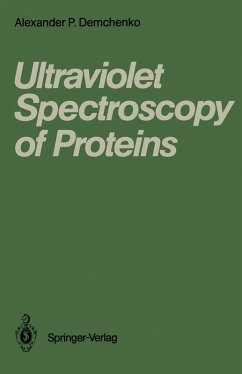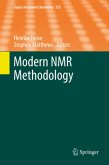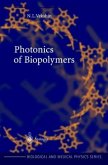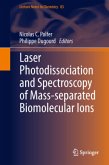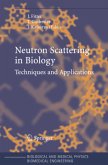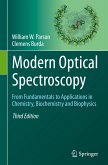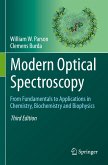Alexander P. Demchenko
Ultraviolet Spectroscopy of Proteins
Alexander P. Demchenko
Ultraviolet Spectroscopy of Proteins
- Broschiertes Buch
- Merkliste
- Auf die Merkliste
- Bewerten Bewerten
- Teilen
- Produkt teilen
- Produkterinnerung
- Produkterinnerung
The aim of this book is to give a comprehensive description of the basic methods used in the ultraviolet spectroscopy of proteins, to discuss new trends and development of these methods, and to analyze their different applications in the study of various aspects of protein structure and dynamics. Ultraviolet spectroscopy is one of the oldest and most popular methods in the field of biochemistry and molecular biophysics. At present, it is difficult to imagine the biochemical laboratory without a recording spectrophotometer or spectrofluorimeter. There are several hundreds of publications…mehr
Andere Kunden interessierten sich auch für
![Fluorescence Spectroscopy in Biology Fluorescence Spectroscopy in Biology]() Martin Hof / Rudolf Hutterer / Vlastimil Fidler (eds.)Fluorescence Spectroscopy in Biology115,99 €
Martin Hof / Rudolf Hutterer / Vlastimil Fidler (eds.)Fluorescence Spectroscopy in Biology115,99 €![Modern NMR Methodology Modern NMR Methodology]() Modern NMR Methodology149,99 €
Modern NMR Methodology149,99 €![Photonics of Biopolymers Photonics of Biopolymers]() Nikolai L. VekshinPhotonics of Biopolymers75,99 €
Nikolai L. VekshinPhotonics of Biopolymers75,99 €![Laser Photodissociation and Spectroscopy of Mass-separated Biomolecular Ions Laser Photodissociation and Spectroscopy of Mass-separated Biomolecular Ions]() Laser Photodissociation and Spectroscopy of Mass-separated Biomolecular Ions75,99 €
Laser Photodissociation and Spectroscopy of Mass-separated Biomolecular Ions75,99 €![Neutron Scattering in Biology Neutron Scattering in Biology]() Neutron Scattering in Biology149,99 €
Neutron Scattering in Biology149,99 €![Modern Optical Spectroscopy Modern Optical Spectroscopy]() William W. ParsonModern Optical Spectroscopy104,99 €
William W. ParsonModern Optical Spectroscopy104,99 €![Modern Optical Spectroscopy Modern Optical Spectroscopy]() William W. ParsonModern Optical Spectroscopy75,99 €
William W. ParsonModern Optical Spectroscopy75,99 €-
-
-
The aim of this book is to give a comprehensive description of the basic methods used in the ultraviolet spectroscopy of proteins, to discuss new trends and development of these methods, and to analyze their different applications in the study of various aspects of protein structure and dynamics. Ultraviolet spectroscopy is one of the oldest and most popular methods in the field of biochemistry and molecular biophysics. At present, it is difficult to imagine the biochemical laboratory without a recording spectrophotometer or spectrofluorimeter. There are several hundreds of publications directly devoted to protein ultraviolet spectroscopy and in a great number of studies UV spectroscopic methods are used for the structural analysis of different proteins. Meanwhile a unified description of the theoretical basis of the methods, experimental techniques, data analysis, and generalization of results obtained in solving the specific problems of protein structure are lacking. There are three reasons for which a monograph on ultraviolet spectroscopy is needed today. Firstly, there has been significant growth in facilities of experimental technique, its precision, and versatility associated with computer data analysts. This new technique is available to a wide circle of scientists engaged in the field of protein research. Most of them are not spectroscopists and, thus, there is a need for a conceivable and precise source of information on how to use this method and what kind of data it should provide.
Produktdetails
- Produktdetails
- Verlag: Springer / Springer Berlin Heidelberg / Springer, Berlin
- Artikelnr. des Verlages: 978-3-642-70849-7
- Softcover reprint of the original 1st ed. 1986
- Seitenzahl: 328
- Erscheinungstermin: 17. November 2011
- Englisch
- Abmessung: 244mm x 170mm x 18mm
- Gewicht: 568g
- ISBN-13: 9783642708497
- ISBN-10: 3642708498
- Artikelnr.: 36120561
- Herstellerkennzeichnung Die Herstellerinformationen sind derzeit nicht verfügbar.
- Verlag: Springer / Springer Berlin Heidelberg / Springer, Berlin
- Artikelnr. des Verlages: 978-3-642-70849-7
- Softcover reprint of the original 1st ed. 1986
- Seitenzahl: 328
- Erscheinungstermin: 17. November 2011
- Englisch
- Abmessung: 244mm x 170mm x 18mm
- Gewicht: 568g
- ISBN-13: 9783642708497
- ISBN-10: 3642708498
- Artikelnr.: 36120561
- Herstellerkennzeichnung Die Herstellerinformationen sind derzeit nicht verfügbar.
1. Spectroscopic Properties of Protein Chromophores.- 1.1 Basic Principles and Definitions of Light Absorption and Emission Spectroscopy.- 1.1.1 Absorption.- 1.1.2 Emission.- 1.2 Light Absorption by the Amide Chromophore..- 1.3 The Absorption Spectra of Amino Acid Residues and Their Analogs.- 1.3.1 Phenylalanine..- 1.3.2 Tyrosine.- 1.3.3 Tryptophan.- 1.3.4 Other Protein Chromophores.- 1.4 Emission Properties of Aromatic Amino Acids.- 1.4.1 Phenylalanine.- 1.4.2 Tyrosine.- 1.4.3 Tryptophan.- 1.5 Conclusions.- 2. Display of Intramolecular and Intermolecular Interactions in Electronic Spectra of Amino Acids and Proteins.- 2.1 Spectroscopic Analysis of the Environmental Polarity and Polarizability Effects.- 2.2 Spectroscopic Manifestation of the Hydrogen Bond.- 2.3 Substitution and Charge Effects.- 2.4 Charge-Transfer Complexes.- 2.5 Broadening of Electronic Spectra.- 2.6 Excited State Processes.- 2.6.1 Solvent Relaxation.- 2.6.2 Exciplexes.- 2.6.3 Excited State Proton Transfer.- 2.6.4 Excited State Electron Transfer.- 2.6.5 On the Nature of the Emitting State of Indole and Tryptophan.- 2.7 Conclusions.- 3. Difference Spectra of Proteins -.- 3.1 Informational Significance of Difference Spectra.- 3.2 Studies of Protein Denaturation.- 3.3 Functional Transformations and Association of Proteins.- 3.3.1 Conformational Changes Under Activation of Precursor Proteins.- 3.3.2 Formation of Enzyme-Substrate and Enzyme-Inhibitor Complexes. Studies on Mechanisms of Catalytic Activity.- 3.3.3 Interaction of Proteins with Small Molecules and Ions.- 3.3.4 Association of Subunits and Formation of Supermolecular Structures.- 3.4 Solvent Perturbation Difference Spectra and Studies in Surface Topography.- of Protein Molecules.- 3.5 Protein-Model Difference Spectra.- 3.6 Conclusions.- 4.Thermal Perturbation Difference Spectroscopy and Temperature-Dependent Conformational Transitions of Proteins.- 4.1 Characteristics of Tyrosine, Tryptophan, and Phenylalanine Spectra and Their Origin.- 4.1.1 Quantitative Analysis of the Experimental Data. Account of Correction Factors.- 4.1.2 TPDS of Tryptophan, Tyrosine, and Phenylalanine.- 4.1.3 Origin of Thermal Perturbation Difference Spectra.- 4.1.4 On the Nature of Longwave Shift with the Temperature Rise.- 4.2 Studies of Thermal Perturbation of Tyrosine, Tryptophan, and Phenylalanine Residues in Proteins.- 4.2.1 Drop in Intensity of TPDS.- 4.2.2 Longwave Shift of TPDS Maxima.- 4.2.3 Absence of Tyrosine Maxima at 287-289 nm.- 4.2.4 Presence of TPDS Maxima in the Region of 300-307 nm.- 4.3 TPDS and Protein Conformational Transitions Depending on Temperature.- and pH of the Medium.- 4.4 Conclusions.- 5. Derivative Spectroscopy of Aromatic Amino Acids and Proteins.- 5.1 The Theoretical Grounds.- 5.2 Derivative Spectra of Tryptophan, Tyrosine, and Phenylalanine.- 5.3 Influence of Solvents on the Derivative Spectra of Aromatic Amino Acids.- 5.4 Analysis of Chromophore Environment in Proteins.- 5.4.1 The State of Phenvlalanine Residues.- 5.4.2 The State of Tyrosine and Tryptophan.- 5.5 Studies of Conformational Transitions in Proteins. Difference-Derivative Spectroscopy.- 5.6 Studies on Broadening of Absorption Spectra.- 5.7 Conclusions.- 6. Spectrophotometric Titration of Proteins.- 6.1 The Spectrophotometric Titration Method.- 6.2 Titration of Tyrosine Residues at Alkaline pH.- 6.3 Conclusions.- 7. Fluorescence Molecular Relaxation Spectroscopy.- 7.1 Relaxational Shift of the Fluorescence Spectra.- 7.2 Time-Resolved Spectroscopy.- 7.3 Edge Excitation Fluorescence Spectroscopy.- 7.3.1 Physical Principles.- 7.3.2 The Effect of Selective Excitation on Fluorescence Spectra of Indole and Tryptophan.- 7.3.3 The Structural Relaxation of Indolic Chromophore in Proteins.- 7.4 Conclusions.- 8. Fluorescence Quenching.- 8.1 Effects of External Difiusional Quenchers.- 8.2 Quenching by Protein Internal Groups and Its Temperature Dependence.- 8.3 Conclusions.- 9. Nonradiative Transfer of Electronic Excitation Energy.- 9.1 General Theory.- 9.2 The Effect of Inhomogeneous Broadening of Spectra and Molecular Relaxation.- on the Nonradiative Transfer of Energy.- 9.3 The Energy Transfer Between Aromatic Amino Acid Residues in Proteins.- 9.4 Conclusions.- 10. Fluorescence Polarization and Rotational Mobility.- 10.1 The Method of Fluorescence Depolarization.- 10.2 The Effect of Dipolar-Reorientational Relaxation on Rotational Depolarization of Fluorescence.- 10.3 Intramolecular Mobility in Proteins as Estimated by Data on Fluorescence Polarization 204 10.4 Conclusions.- 11. Intrinsic Phosphorescence of Proteins.- 11.1 General Mechanisms of Phosphorescence.- 11.1.1 The Principle of the Method,.- 11.1.2 Inhomogeneous Broadening and Molecular Relaxations in Spectroscopy of the Triplet State.- 11.1.3 Indole and Tryptophan Phosphorescence.- 11.2 Phosphorescence Assay of Protein Structures.- 11.2.1 Low-Temperature Phosphorescence.- 11.2.2 Temperature Dependence of Phosphorescence Parameters.- 11.2.3 Phosphorescence of Proteins and Membranes at Room Temperature.- 11.2.4 Phosphorescence and Optically Detected Magnetic Resonance.- 11.3 Conclusions.- 12. Employment of Ultraviolet Spectroscopy in Analytical Chemistry of Proteins.- 12.1 A Method for the Quantitative Spectroscopic Determination of Protein Concentration.- 12.1.1 Determination of Protein Concentration in the 280 nm Region.- 12.1.2 Determination of Protein Concentration in the Far-Ultraviolet Region.- 12.1.3 Determination of Protein Concentration in the Presence of Other Light-Absorbing Substances.- 12.2 Determination of Tryptophan, Tyrosine, and Phenylalanine Content in Proteins.- 12.2.1 Determination of Tyrosine and Tryptophan Concentration by Absorption Spectra..- 12.2.2 Determination of Tyrosine, Tryptophan, and Phenylalanine by Use of Derivatives of the Absorption Spectrum.- 12.2.3 Employment of the Method of Difference and Thermal Perturbation Difference Spectra.- 12.2.4 Fluorescence Spectroscopic Tryptophan and Tyrosine Assay.- 12.3 Spectroscopic Studies of Peptide Bond Splitting in Protein Hydrolysis.- 12.4 Study of the Modification and Oxidation of Chromophore Groups.- 12.5 Hydrogen-Deuterium Exchange in Peptides and Proteins.- 12.6 Conclusions.- 13. Experimental Technique in Protein Spectroscopy.- 13.1 Spectrophotometric Analysis.- 13.1.1 Spectrophotometers, Their Main Characteristics and Calibration.- 13.1.2 Peculiarities of Recording the Difference Spectra of Proteins.- 13.1.3 Difference Spectra of Protein Preparations Differing in Initial Concentration.- 13.1.4 The Recording of Derivative Spectra.- 13.1.5 Turbidity of Protein Preparation and Possibilities of Its Account.- 13.2 Technique of Luminescence Studies.- 13.2.1 Steady State Spectra of Excitation and Fluorescence.- 13.2.2 Technique of Polarization Measurements.- 13.2.3 Technique of Time-Resolved Fluorimetry.- 13.2.4 Technique of Phosphorescence Studies.- 13.3 Multiparametric Detection and Analysis of Spectroscopic Data.- 13.4 Conclusions.- 14. General Conclusions and Prospects.- 14.1 Advantages and Limitations of Molecular Probe Methods.- 14.2 The Comparative Analysis of UV-Spectroscopic Information and the Data.- of X-Ray Diffraction Analysis andNMR.- 14.3 The Spectroscopic Manifestation of the Dynamic Nature of Proteins.- 14.3.1 Distribution of Microstates.- 14.3.2 Analysis of the Dynamics by Emission Spectrscopy.- 14.3.3 Conformational Dynamics and Functional Properties of Proteins.- 14.4 Subject and Method in Protein Spectroscopy.- References.
1. Spectroscopic Properties of Protein Chromophores.- 1.1 Basic Principles and Definitions of Light Absorption and Emission Spectroscopy.- 1.1.1 Absorption.- 1.1.2 Emission.- 1.2 Light Absorption by the Amide Chromophore..- 1.3 The Absorption Spectra of Amino Acid Residues and Their Analogs.- 1.3.1 Phenylalanine..- 1.3.2 Tyrosine.- 1.3.3 Tryptophan.- 1.3.4 Other Protein Chromophores.- 1.4 Emission Properties of Aromatic Amino Acids.- 1.4.1 Phenylalanine.- 1.4.2 Tyrosine.- 1.4.3 Tryptophan.- 1.5 Conclusions.- 2. Display of Intramolecular and Intermolecular Interactions in Electronic Spectra of Amino Acids and Proteins.- 2.1 Spectroscopic Analysis of the Environmental Polarity and Polarizability Effects.- 2.2 Spectroscopic Manifestation of the Hydrogen Bond.- 2.3 Substitution and Charge Effects.- 2.4 Charge-Transfer Complexes.- 2.5 Broadening of Electronic Spectra.- 2.6 Excited State Processes.- 2.6.1 Solvent Relaxation.- 2.6.2 Exciplexes.- 2.6.3 Excited State Proton Transfer.- 2.6.4 Excited State Electron Transfer.- 2.6.5 On the Nature of the Emitting State of Indole and Tryptophan.- 2.7 Conclusions.- 3. Difference Spectra of Proteins -.- 3.1 Informational Significance of Difference Spectra.- 3.2 Studies of Protein Denaturation.- 3.3 Functional Transformations and Association of Proteins.- 3.3.1 Conformational Changes Under Activation of Precursor Proteins.- 3.3.2 Formation of Enzyme-Substrate and Enzyme-Inhibitor Complexes. Studies on Mechanisms of Catalytic Activity.- 3.3.3 Interaction of Proteins with Small Molecules and Ions.- 3.3.4 Association of Subunits and Formation of Supermolecular Structures.- 3.4 Solvent Perturbation Difference Spectra and Studies in Surface Topography.- of Protein Molecules.- 3.5 Protein-Model Difference Spectra.- 3.6 Conclusions.- 4.Thermal Perturbation Difference Spectroscopy and Temperature-Dependent Conformational Transitions of Proteins.- 4.1 Characteristics of Tyrosine, Tryptophan, and Phenylalanine Spectra and Their Origin.- 4.1.1 Quantitative Analysis of the Experimental Data. Account of Correction Factors.- 4.1.2 TPDS of Tryptophan, Tyrosine, and Phenylalanine.- 4.1.3 Origin of Thermal Perturbation Difference Spectra.- 4.1.4 On the Nature of Longwave Shift with the Temperature Rise.- 4.2 Studies of Thermal Perturbation of Tyrosine, Tryptophan, and Phenylalanine Residues in Proteins.- 4.2.1 Drop in Intensity of TPDS.- 4.2.2 Longwave Shift of TPDS Maxima.- 4.2.3 Absence of Tyrosine Maxima at 287-289 nm.- 4.2.4 Presence of TPDS Maxima in the Region of 300-307 nm.- 4.3 TPDS and Protein Conformational Transitions Depending on Temperature.- and pH of the Medium.- 4.4 Conclusions.- 5. Derivative Spectroscopy of Aromatic Amino Acids and Proteins.- 5.1 The Theoretical Grounds.- 5.2 Derivative Spectra of Tryptophan, Tyrosine, and Phenylalanine.- 5.3 Influence of Solvents on the Derivative Spectra of Aromatic Amino Acids.- 5.4 Analysis of Chromophore Environment in Proteins.- 5.4.1 The State of Phenvlalanine Residues.- 5.4.2 The State of Tyrosine and Tryptophan.- 5.5 Studies of Conformational Transitions in Proteins. Difference-Derivative Spectroscopy.- 5.6 Studies on Broadening of Absorption Spectra.- 5.7 Conclusions.- 6. Spectrophotometric Titration of Proteins.- 6.1 The Spectrophotometric Titration Method.- 6.2 Titration of Tyrosine Residues at Alkaline pH.- 6.3 Conclusions.- 7. Fluorescence Molecular Relaxation Spectroscopy.- 7.1 Relaxational Shift of the Fluorescence Spectra.- 7.2 Time-Resolved Spectroscopy.- 7.3 Edge Excitation Fluorescence Spectroscopy.- 7.3.1 Physical Principles.- 7.3.2 The Effect of Selective Excitation on Fluorescence Spectra of Indole and Tryptophan.- 7.3.3 The Structural Relaxation of Indolic Chromophore in Proteins.- 7.4 Conclusions.- 8. Fluorescence Quenching.- 8.1 Effects of External Difiusional Quenchers.- 8.2 Quenching by Protein Internal Groups and Its Temperature Dependence.- 8.3 Conclusions.- 9. Nonradiative Transfer of Electronic Excitation Energy.- 9.1 General Theory.- 9.2 The Effect of Inhomogeneous Broadening of Spectra and Molecular Relaxation.- on the Nonradiative Transfer of Energy.- 9.3 The Energy Transfer Between Aromatic Amino Acid Residues in Proteins.- 9.4 Conclusions.- 10. Fluorescence Polarization and Rotational Mobility.- 10.1 The Method of Fluorescence Depolarization.- 10.2 The Effect of Dipolar-Reorientational Relaxation on Rotational Depolarization of Fluorescence.- 10.3 Intramolecular Mobility in Proteins as Estimated by Data on Fluorescence Polarization 204 10.4 Conclusions.- 11. Intrinsic Phosphorescence of Proteins.- 11.1 General Mechanisms of Phosphorescence.- 11.1.1 The Principle of the Method,.- 11.1.2 Inhomogeneous Broadening and Molecular Relaxations in Spectroscopy of the Triplet State.- 11.1.3 Indole and Tryptophan Phosphorescence.- 11.2 Phosphorescence Assay of Protein Structures.- 11.2.1 Low-Temperature Phosphorescence.- 11.2.2 Temperature Dependence of Phosphorescence Parameters.- 11.2.3 Phosphorescence of Proteins and Membranes at Room Temperature.- 11.2.4 Phosphorescence and Optically Detected Magnetic Resonance.- 11.3 Conclusions.- 12. Employment of Ultraviolet Spectroscopy in Analytical Chemistry of Proteins.- 12.1 A Method for the Quantitative Spectroscopic Determination of Protein Concentration.- 12.1.1 Determination of Protein Concentration in the 280 nm Region.- 12.1.2 Determination of Protein Concentration in the Far-Ultraviolet Region.- 12.1.3 Determination of Protein Concentration in the Presence of Other Light-Absorbing Substances.- 12.2 Determination of Tryptophan, Tyrosine, and Phenylalanine Content in Proteins.- 12.2.1 Determination of Tyrosine and Tryptophan Concentration by Absorption Spectra..- 12.2.2 Determination of Tyrosine, Tryptophan, and Phenylalanine by Use of Derivatives of the Absorption Spectrum.- 12.2.3 Employment of the Method of Difference and Thermal Perturbation Difference Spectra.- 12.2.4 Fluorescence Spectroscopic Tryptophan and Tyrosine Assay.- 12.3 Spectroscopic Studies of Peptide Bond Splitting in Protein Hydrolysis.- 12.4 Study of the Modification and Oxidation of Chromophore Groups.- 12.5 Hydrogen-Deuterium Exchange in Peptides and Proteins.- 12.6 Conclusions.- 13. Experimental Technique in Protein Spectroscopy.- 13.1 Spectrophotometric Analysis.- 13.1.1 Spectrophotometers, Their Main Characteristics and Calibration.- 13.1.2 Peculiarities of Recording the Difference Spectra of Proteins.- 13.1.3 Difference Spectra of Protein Preparations Differing in Initial Concentration.- 13.1.4 The Recording of Derivative Spectra.- 13.1.5 Turbidity of Protein Preparation and Possibilities of Its Account.- 13.2 Technique of Luminescence Studies.- 13.2.1 Steady State Spectra of Excitation and Fluorescence.- 13.2.2 Technique of Polarization Measurements.- 13.2.3 Technique of Time-Resolved Fluorimetry.- 13.2.4 Technique of Phosphorescence Studies.- 13.3 Multiparametric Detection and Analysis of Spectroscopic Data.- 13.4 Conclusions.- 14. General Conclusions and Prospects.- 14.1 Advantages and Limitations of Molecular Probe Methods.- 14.2 The Comparative Analysis of UV-Spectroscopic Information and the Data.- of X-Ray Diffraction Analysis andNMR.- 14.3 The Spectroscopic Manifestation of the Dynamic Nature of Proteins.- 14.3.1 Distribution of Microstates.- 14.3.2 Analysis of the Dynamics by Emission Spectrscopy.- 14.3.3 Conformational Dynamics and Functional Properties of Proteins.- 14.4 Subject and Method in Protein Spectroscopy.- References.

